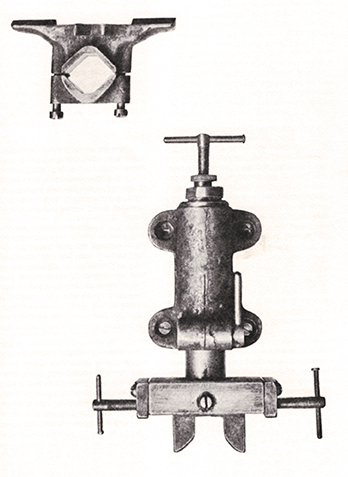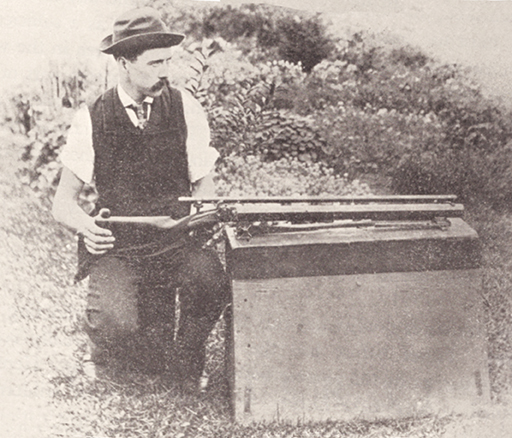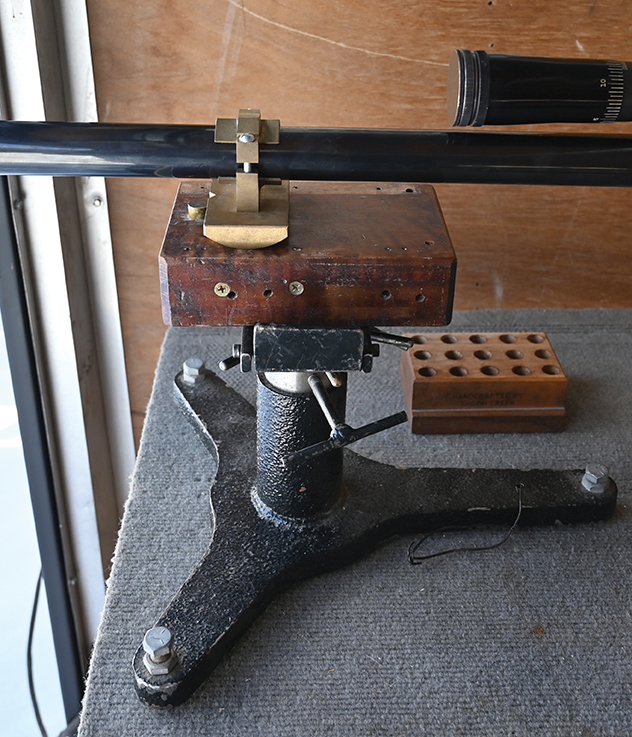Testing a Rifle
feature By: Steve Garbe | June, 25

“For close groups a Pope double machine rest, which I have developed, is needed to determine the ultimate accuracy of any barrel. More information can be derived from its use in a few hours than can be had by ordinary rest shooting by an ordinary shooter in as many weeks, as, if at all carefully used, it has no human errors of holding and pulling. The results, therefore, are those due to rifle ammunition, and weather only; the man is out of it except so far as his loading of the rifle and judgment of the wind are concerned. The mounts are all adjustable and clamp to the barrel, no screw holes or marring of the barrel being necessary. They take barrels of all ordinary sizes without change, the forearm being removed while testing. In use, two stout posts are set deeply in the ground, the firmer, the better, and are braced together. A stop is fastened on the top plank in the proper position, and rear rest to rear post so as to give approximately the correct elevation. Front rest and scope mountings are clamped to the barrel, the same loaded, and slid gently to the stop. To sight on I prefer four black pasters placed at the corners of a square about 2 ½ inches on a side. Adjust your rest or telescope, or perhaps both, so that the gun points where you wish, cross-hairs being between each pair of pasters. Let the rifle rest naturally, hold the right hand about six inches behind the butt, touch the set trigger with the left hand, and catch the rifle on recoil. If the gun has a heavy pull, pinch the trigger and guard with the thumb and forefinger so as not to disturb the rifle in the rest.
A telescope sight is not necessary in double rest shooting, though it is a great convenience. With it you can shoot from a bench rest that is not firm, as the sight gives you a chance to correct the aim each time. For all that, an absolutely firm bench is best, and if you shoot from a double rest without a scope it is an absolute necessity.

If we are going to begin load development with any new rifle, then we first have to determine that it is a precision combination. This cannot be done in a situation where the rifleman himself may introduce a myriad of variations simply from his technique of holding and shooting. Variables as to hold, trigger pull, sighting and recoil management must be reduced or preferably eliminated in order to establish the ultimate precision of the rifle, before tacking the problems of making it perform in a match situation. It is “getting the cart before the horse” to test a rifle in anything other than at least a return-to-battery, double rest, benchrest set-up, where the results can be closely duplicated. A general idea of rifle’s capability can be determined through repeated testing from other rests, but as Harry said, “More information can be obtained from less shooting by using a machine rest than through any other way.” The variations that can be introduced by the shooter must be eliminated in order that one can focus on the variations introduced by ammunition.

One of the machine rest’s big advantages is when the rifle is returned to battery, it is in the exact same place on the rest that it was for the proceeding shot. In this way, variations in sighting are eliminated. It is interesting to note, when shooting with a machine rest, if there is any mirage present on the range, the amount that the target seems to “move” even though you know that the rifle is back to the exact same place. It points out how futile it can be to test ammunition in even light mirage, when the shooter will hold differently for each shot based on what he sees through the sights.
Many riflemen today think that using a machine rest is a complicated process. To the contrary, using a Pope-style machine rest is very simple. Mount the rear hardware to a suitable plank, which has been finished with a sanded finish on which the barrel clamp can slide smoothly. I have found that mounting the barrel-clamp about six inches from the muzzle to work well on most rifles. Install a brass or steel index pin for the muzzle clamp at the front of the plank. Remove the forearm from the rifle and let the barrel ride in the rear mount, pushing the barrel forward to engage the pin in the v-notch of the barrel clamp. I usually sit at the left side of the rest, using my left hand to trip the trigger and stop the rifle with my right hand as it recoils backwards. As with all accurate shooting, consistency in technique is key, the most important thing being to not restrict the rifle’s rearward movement until the bullet has cleared the muzzle.

For the rimfire rifleman trying determine the best lot of a specific ammunition brand, the machine rest is invaluable. Rimfires can be very picky as to what brand of ammunition they like, even down to specific lots. When I worked at Ballard Rifle & Cartridge Co., I would frequently test new .22 match rifles before being delivered to the customer by shooting from machine rest at night after work. The length of the shop gave me a 40-yard range into a bullet trap that wasn’t influenced by outdoor conditions. Usually, after no more than an hour’s testing, I could give the customer a solid recommendation as to what brand and lot number of ammunition his new Ballard .22 would like.

If the rifleman cannot get access to a true machine rest, using the muzzle clamp on a front bench rest with a flat top and indexing pin in a double rest set-up can yield nearly as good a result. The muzzle clamp prevents canting and the pin assures that the rifle will be back to the same position. This is also a more convenient set up to use in a match where allowances for wind must be quickly made. Of course, the shooter will be positioned behind the rifle rather than alongside and varying degrees of rifle restraint can be used, from free recoil to a hard hold.
At the end of the day, eliminating shooter–induced variables is the key to the successful testing of a rifle and its ammunition. Only by using a proper double or machine rest can we arrive at correct conclusions in the shortest period of time, keeping ammunition costs and barrel-wear to a minimum.


